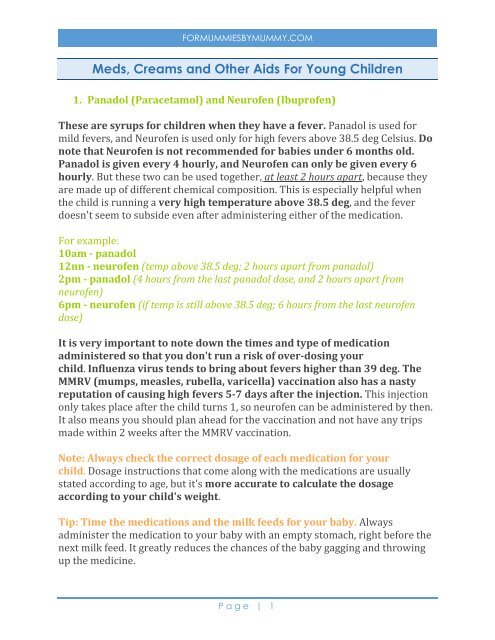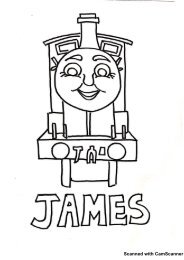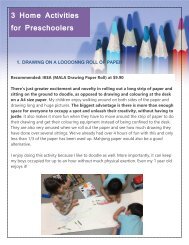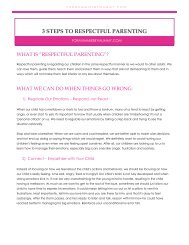Meds, Creams and Other Aids
You also want an ePaper? Increase the reach of your titles
YUMPU automatically turns print PDFs into web optimized ePapers that Google loves.
FORMUMMIESBYMUMMY.COM<br />
<strong>Meds</strong>, <strong>Creams</strong> <strong>and</strong> <strong>Other</strong> <strong>Aids</strong> For Young Children<br />
1. Panadol (Paracetamol) <strong>and</strong> Neurofen (Ibuprofen)<br />
These are syrups for children when they have a fever. Panadol is used for<br />
mild fevers, <strong>and</strong> Neurofen is used only for high fevers above 38.5 deg Celsius. Do<br />
note that Neurofen is not recommended for babies under 6 months old.<br />
Panadol is given every 4 hourly, <strong>and</strong> Neurofen can only be given every 6<br />
hourly. But these two can be used together, at least 2 hours apart, because they<br />
are made up of different chemical composition. This is especially helpful when<br />
the child is running a very high temperature above 38.5 deg, <strong>and</strong> the fever<br />
doesn't seem to subside even after administering either of the medication.<br />
For example:<br />
10am - panadol<br />
12nn - neurofen (temp above 38.5 deg; 2 hours apart from panadol)<br />
2pm - panadol (4 hours from the last panadol dose, <strong>and</strong> 2 hours apart from<br />
neurofen)<br />
6pm - neurofen (if temp is still above 38.5 deg; 6 hours from the last neurofen<br />
dose)<br />
It is very important to note down the times <strong>and</strong> type of medication<br />
administered so that you don't run a risk of over-dosing your<br />
child. Influenza virus tends to bring about fevers higher than 39 deg. The<br />
MMRV (mumps, measles, rubella, varicella) vaccination also has a nasty<br />
reputation of causing high fevers 5-7 days after the injection. This injection<br />
only takes place after the child turns 1, so neurofen can be administered by then.<br />
It also means you should plan ahead for the vaccination <strong>and</strong> not have any trips<br />
made within 2 weeks after the MMRV vaccination.<br />
Note: Always check the correct dosage of each medication for your<br />
child. Dosage instructions that come along with the medications are usually<br />
stated according to age, but it's more accurate to calculate the dosage<br />
according to your child's weight.<br />
Tip: Time the medications <strong>and</strong> the milk feeds for your baby. Always<br />
administer the medication to your baby with an empty stomach, right before the<br />
next milk feed. It greatly reduces the chances of the baby gagging <strong>and</strong> throwing<br />
up the medicine.<br />
P a g e | 1
FORMUMMIESBYMUMMY.COM<br />
2. Syringes<br />
Syringes are very useful in administering small doses of medication for the baby.<br />
They can be found in pharmacies. Most commonly used ones are the 3ml <strong>and</strong><br />
5ml sizes.<br />
Tip: Insert the syringe into the corner of baby's mouth so prevent gagging<br />
<strong>and</strong> spitting.<br />
3. Suppositories for Fever<br />
Trying to soothe a baby who is unwell can be very heartbreaking. It's even<br />
tougher to be the one to administer the medication to the child, <strong>and</strong> watch her<br />
struggle or gag at the taste of the medicine. I've learnt to request for<br />
suppositories from my pediatrician because these can be administered even<br />
when the baby is asleep.<br />
There are paracetamol <strong>and</strong> ibuprofen equivalent in the form of<br />
suppositories, so different type of suppositories can be given for mild fever<br />
<strong>and</strong> high fever.<br />
Note: Suppositories need to be kept in the fridge.<br />
Tip: Before you insert the suppository, warm it by rubbing it with your<br />
fingers or running it under tap water for several seconds. This will smooth<br />
out the edges so it's easier to insert the suppository up the baby's butt. It's also<br />
easier when the baby is lying on her side with the legs bent. Simply push the<br />
suppository in, with the tip pointing towards the baby's belly button.<br />
4. Cold / Hot Pack with Towel<br />
Packs are used hot by immersing in boiling water for 5-10 minutes, or can be<br />
warmed up in the microwave oven. For use as cold packs, simply place them in<br />
the freezer. It's a good idea to just leave the cold pack in the freezer. Trust me, I<br />
use it very often.<br />
Use the cold packs for cold compress on bruises <strong>and</strong> swelling when the child<br />
falls down. Compress for about 15-20 minutes right after the fall for best<br />
results. Continue to cold compress 2-3 times in the day over the next few<br />
days for faster recovery of the bruise or swelling.<br />
P a g e | 2
FORMUMMIESBYMUMMY.COM<br />
Use the cold pack (preferably a large sized one) <strong>and</strong> place it inside the<br />
shirt/romper of your child's back when the child is having a fever. Very<br />
useful when it takes time for effects of fever meds to kick in.<br />
5. Fever Patches<br />
Fever patches are very easy to use. Simply peel off the back <strong>and</strong> stick it to your<br />
baby's forehead! It will keep the area cool for 4-8 hours, which makes it useful at<br />
night when child is asleep, <strong>and</strong> even in the day when child is active. These are<br />
also one of my must-bring items when we travel with the children.<br />
6. Thermometer<br />
It's essential to have a trusty thermometer to monitor the child's temperature<br />
when he's having a fever, because different medications can be given for varying<br />
temperatures.<br />
I highly recommend Braun's In-Ear Thermometer. It takes less than 3<br />
seconds to record the temperature reading, <strong>and</strong> shows the reading with either a<br />
green, yellow or red light to indicate normal, fever or high fever. It also allows<br />
you to select the age of the child for 0-3 months, 3-36 months, <strong>and</strong> over 36<br />
months, for a more accurate diagnosis of whether the child is indeed having a<br />
fever. You can also choose to see the reading either in Celsius or Fahrenheit.<br />
7. Hydrocortisone Cream 1%<br />
This is a steroidal cream used for rashes, itch, skin allergies <strong>and</strong> even insect<br />
bites. I've used it on my first child when he was several months old at the<br />
recommendation of the pediatrician because he has sensitive skin <strong>and</strong> rash<br />
appeared on his face rather frequently. You can also get the Hydrocortisone<br />
Cream directly from the Pharmacist. Do note that the pharmacist would not<br />
recommend use for children under 3 because the child's rash condition<br />
should be monitored for use of a steroid cream. It's important to only apply<br />
a thin layer of the cream on the affected area, once or twice a day, for not<br />
more than 2 weeks. The cream may cause discolouration <strong>and</strong> thin the skin over<br />
frequent usage. Note also to avoid the eyes or any open wound.<br />
When my baby has very bad diaper rash, I would apply some Hydrocortisone on<br />
the affected area, before applying diaper cream.<br />
P a g e | 3
FORMUMMIESBYMUMMY.COM<br />
8. Physiogel AI Cream<br />
Physiogel is known for its various creams <strong>and</strong> body lotions for sensitive<br />
skin. The Physiogel AI cream was recommended for young children by my<br />
pediatrician for my son's mild eczema condition when he was only a few<br />
months old. It is a very effective moisturiser in soothing or preventing any<br />
redness or irritation on the skin.<br />
9. Zyrtec (Cetirizine) <strong>and</strong> Chlorpheniramine<br />
These are anti-histamines for allergies, sneezing, itching <strong>and</strong> runny<br />
nose. The Zyrtec syrup comes in banana flavour for kids, but I personally find the<br />
smell unbearable. It was a nightmare giving it to my daughter when she had to<br />
take it at around 6 months. She totally disliked the taste. After giving feedback to<br />
my pediatrician, she gave us Chlorpheniramine instead, which my daughter took<br />
well.<br />
Chlorpheniramine tends to cause more drowsiness as compared to Zyrtec. But I<br />
actually prefer that my children take meds that will make them drowsy so they<br />
can nap more when they are unwell.<br />
10. Dimetapp<br />
Dimetapp consists of brompheniramine <strong>and</strong> phenylephrine, which is an<br />
antihistamine <strong>and</strong> a decongestant respectively. It can be used for common<br />
cold, sneezing, runny or stuffy nose. It's supposed to be a stronger med as<br />
compared to Zyrtec <strong>and</strong> Chlorpheniramine, which is why my pediatrician<br />
recommended these for my boys, but not for my daughter under 2. Dimetapp<br />
can be purchased directly from the Pharmacist.<br />
11. Rhinathiol Promethazine<br />
This consists of carbocisteine which is a mucolytic that helps to reduce viscosity<br />
of sputum, <strong>and</strong> promethazine hydrochloride which is an antihistamine.<br />
So Rhinathiol Promethazine can be used for coughs <strong>and</strong> to reduce phlegm.<br />
When my boys suffer from cough <strong>and</strong> runny nose, I would give them both<br />
dimetapp <strong>and</strong> rhinathiol promethazine. Note that these two meds are not<br />
recommended for children under 2 years.<br />
P a g e | 4
FORMUMMIESBYMUMMY.COM<br />
Note: The antihistamines in the meds may cause drowsiness, which affect<br />
different children to different extent, so it's also important to monitor your<br />
children when they are given sedative medications.<br />
12. Abrilar / Prospan<br />
Abrilar is a cough syrup made from ivy leaves dry extract. It's very safe for<br />
even babies under 1 year, pregnant mums <strong>and</strong> nursing mums. It has a pleasant<br />
taste too, which was well-approved by my daughter. This is an OTC (over-thecounter)<br />
medicine.<br />
13. Nebuliser<br />
Well, the nebuliser is not exactly an aid to keep at home. It is largely used for<br />
children who suffer from severe asthma. However, when my daughter suffered<br />
bronchiolitis when she was 6 months old, after her first dip in the pool, she<br />
had fever then developed a very nasty cough over two weeks,<strong>and</strong> didn't<br />
take the medicines well. The pediatrician hence suggested I rent home the<br />
nebuliser for her. Basically the nebuliser converts liquid medicines into gas, so<br />
you just have to bring the small face mask close to your child's nose for her to<br />
breathe in the gas. It's odourless, so you don't have to worry about any bad<br />
smell putting off your child. However, the young child might be bothered by the<br />
whirring sound of the nebuliser when it's switched on. Also, the medications are<br />
definitely more expensive than the typical oral meds, <strong>and</strong> you would also have to<br />
pay a rental fee to bring the machine home over a few days. The nebuliser<br />
worked well for us, <strong>and</strong> the medication course is much more effective <strong>and</strong> only<br />
required three days, as compared to her probably having to take the oral meds<br />
for a week.<br />
Knowing your options for different types of medicines <strong>and</strong> different<br />
ways of administering the meds will help you in deciding, along with<br />
your physician, the best method to treat your child, in the least<br />
unpleasant manner.<br />
Disclaimer: My suggestions here are based on personal experience on how I care for my 3<br />
children at home, which you might also find useful. If you have any doubts, you should always<br />
consult a medical professional.<br />
P a g e | 5








